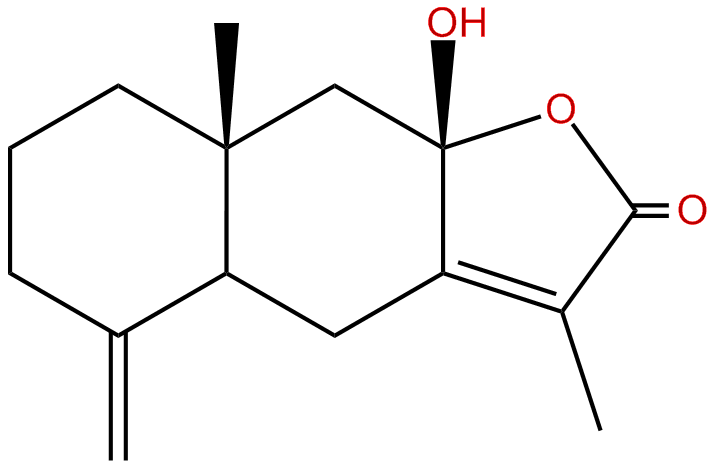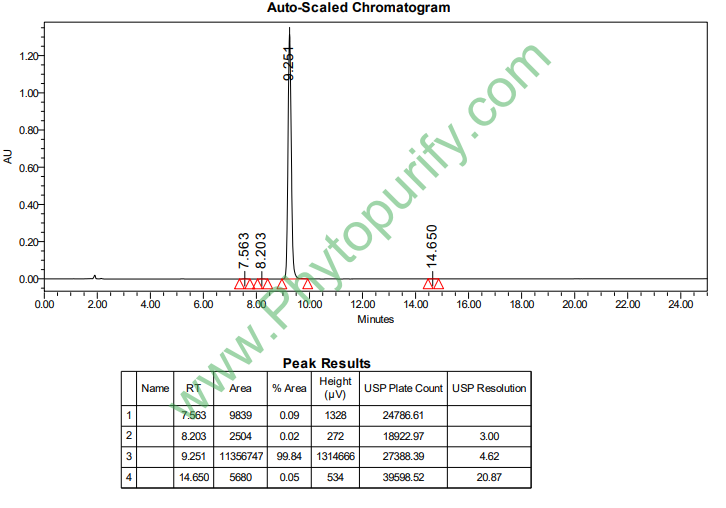
Atractylenolide IIICAS No.:73030-71-4
|
||||||||||
 |
|
|
||||||||

| Catalogue No.: | BP0216 |
| Formula: | C15H20O3 |
| Mol Weight: | 248.322 |
Product name: Atractylenolide III
Synonym name: Atractylenolide beta; Codonolactone
Catalogue No.: BP0216
Cas No.: 73030-71-4
Formula: C15H20O3
Mol Weight: 248.322
Botanical Source: Aster umbellatus, Atractylodes sp., Codonopsis pilosula and Chloranthus japonicus
Physical Description: White cryst.
Type of Compound: Sesquiterpenoids
Purity: 95%~99%
Analysis Method: HPLC-DAD or/and HPLC-ELSD
Identification Method: Mass, NMR
Packing: Brown vial or HDPE plastic bottle
Storage: Store in a well closed container, protected from air and light. Put into refrigerate or freeze for long term storage.
Whenever possible, you should prepare and use solutions on the same day. However, if you need to make up stock solutions in advance, we recommend that you store the solution as aliquots in tightly sealed vials at -20℃. Generally, these will be useable for up to two weeks.
The product could be supplied from milligrams to grams, up to kilograms
Inquire for bulk scale.
Descriptions:
Atractylenolide III is the major bioactive component of Atractylodes lancea, it inhibits histamine release, suppresses activation of p38 mitogen-activated protein kinase, C-Jun-N-terminal protein kinase, and nuclear factor-κB in stimulated HMC-1 cells, and suppresses the activation of caspase-1 and the expression of receptor interacting protein-2, suggests that atractylenolide III may control immunological reactions by regulating the cellular functions of IL-6 in mast cells.[1]
Atractylenolide III and atractylenolide I have anti-inflammatory activity through inhibition of nuclear factor-κB and mitogen-activated protein kinase pathways in mouse macrophages, can inhibit Lipopolysaccharide-induced TNF- α and NO production in macrophages.[2,3]
Atractylenolide III can induce apoptosis in human lung carcinoma A549 cells via mitochondria-mediated death pathway, indicates that it is a potential candidate for treatment of human lung carcinoma.[4]
Atractylenolide III (LD50, 103.3 mg/m2) and atractylon (136.2 mg/m2) are potential house dust mite control agents, they are five and four times more toxic than Deet and 1.7- and 1.3-fold more active than dibutyl phthalate, respectively, based on 24 h LD50 values. [5]
Atractylenolide III has neuroprotection against glutamate-induced neuronal apoptosis via inhibiting caspase signaling pathway.[6]
Atractylenolide III has gastroprotective activity on ethanol-induced gastric ulcer in vitro and in vivo.[7]
References:
[1] Kang T H, Han N R, Kim H M, et al. J Nat Prod, 2011, 74(2):223-7.
[2]Li C Q, He L C, Jin J Q. Phytother Res, 2007, 21(4):347–53.
[3] Ji G Q, Chen R Q, Wang L. Immunopharmacol Immunot, 2015,38(2):98-102.
[4] Kang T H, Bang J Y, Kim M H, et al. Food Chem Toxicol , 2011, 49(2):514-9.
[5] Kim H K, Yun Y K, Ahn Y J. J Agri Food Chem, 2007, 55(15):6027-31.
[6] Liu C, Zhao H, Ji Z H, et al. Neurocheml Res, 2014, 39(9):1753-8.
[7] Wang K T, Chen L G, Wu C H, et al. J Pharm Pharmacol, 2010, 62(3):381-8.
[8] Ying Guo, Yong Chun Jin,Ke Yuan,et al. Asian Journal of Chemistry,2012, 24(10):4425-8
HPLC of Atractylenolide III
